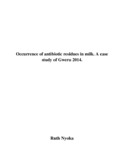Please use this identifier to cite or link to this item:
https://cris.library.msu.ac.zw//handle/11408/3510Full metadata record
| DC Field | Value | Language |
|---|---|---|
| dc.contributor.author | Nyoka, Ruth | - |
| dc.date.accessioned | 2019-04-02T10:42:50Z | - |
| dc.date.available | 2019-04-02T10:42:50Z | - |
| dc.date.issued | 2014 | - |
| dc.identifier.uri | http://hdl.handle.net/11408/3510 | - |
| dc.description.abstract | The aim of the research was to determine the occurrence of antibiotic residues in milk in Gweru. The population consisted of twenty-eight farmers. Ten farmers were randomly selected from the population. The average volume that the farmers supply to dairy processing companies was twenty thousand liters during the time of sampling. Raw milk was sampled in two hundred and fifty mls sterile sample bottles. The samples were frozen up to the time of analysis. Detection and quantitation of antibiotic residues was done using High Performance Liquid Chromatography coupled to a mass spectroscopy detector (HPLC-MS). Fourteen antibiotics were analyzed for and these are: the sulphonamides,(trimethoprin, sulfaquinoxali, sulfamethoxin, sulfamethoxazole, sulfamethizole, sulfamethazine and sulfachloropyril), the steroids dexamethasone, the flouroquinolones which is enrofloxacin , the β-Lactams which is Penicillin G and amoxicillin as well as the Benzimidazoles which are thiabendazole and albendazole. Only one antibiotic which is albendazole was detectable on the two analyses which were done separately on the qualitative HPLC-MS machine in all the samples. The quantities of the albendazole were then quantified on the Quantitative HPLC-MS machine. During the first analysis farmer A had 241.31ppb albendazole and this was above 100ppb which is the Codex maximum residual limit for albendazole. On the second analysis done farmers ,A, B, C, D, E, F had 239.8ppb, 118.34ppb, 140.63ppb, 254.13ppb, 252.57ppb and 198.62ppb respectively which were above the 100ppb Codex Standard and other farmers were below 100ppb. T-test at 95% significance level showed that there is no significant difference in antibiotic concentration among Dairy farmers that supply milk to Dairy processing companies around Gweru. The effect of albendazole on fermentation of milk was done using back fermentation with 40ml of fermented milk in 500ml of fresh milk. Albendazole was added at different concentrations which were 0, 100, 500, 750, 1000 and 2000μL. pH was measured using a pH meter and lactic acid content was determined by using freshly prepared 0.1N sodium hydroxide. Albendazole slows down the rate of fermentation as pH and percentage lactic acid content was less in the sample with 2000μl albendazole added. pH change was highest in the samples with no antibiotic added. One way ANOVA done at 99% significance level showed that the lactic acid content vary significantly with antibiotic concentration. Regression analysis showed that there is a strong positive correlation (R2= 0.967) between antibiotic concentration and percentage lactic acid. | en_US |
| dc.language.iso | en | en_US |
| dc.publisher | Midlands State University | en_US |
| dc.subject | Antibiotic residues | en_US |
| dc.subject | Raw milk | en_US |
| dc.title | Occurrence of antibiotic residues in milk: a case study of Gweru 2014. | en_US |
| item.grantfulltext | open | - |
| item.languageiso639-1 | en | - |
| item.fulltext | With Fulltext | - |
| Appears in Collections: | Master Of Science In Food Science And Nutrition Degree | |
Files in This Item:
| File | Description | Size | Format | |
|---|---|---|---|---|
| nyokaruth.pdf | Full Text | 1.67 MB | Adobe PDF |  View/Open |
Page view(s)
152
checked on Apr 21, 2025
Download(s)
78
checked on Apr 21, 2025
Google ScholarTM
Check
Items in MSUIR are protected by copyright, with all rights reserved, unless otherwise indicated.



